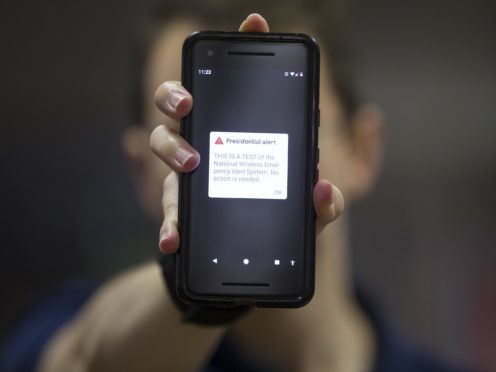Electronic devices across the United States sounded off as the Federal Emergency Management Agency conducted its first-ever national wireless emergency alert test.
The tone went off at 2:18 p.m EDT (Eastern Daylight Time).
The subject of the alert read: Presidential Alert and text said: “This is a test of the National Wireless Emergency Alert System. No action is needed.”
Fema officials estimated that about 225 million devices would receive the alert at about the same time, but the message was broadcast by mobile towers for 30 minutes so some people got it later than others.
📳 TODAY (10/3): At 2:18 PM EDT, we will be testing the Wireless Emergency Alert system nationwide. Expect a message box on your phone along with a loud tone and vibration.
Questions? Visit https://t.co/Op8T9AEpiF pic.twitter.com/cCXJGGObPP
— FEMA (@fema) October 3, 2018
Some got as many as four alerts on their phones; others did not get any.
In a real emergency, devices would get the alert at the same time or as close to the same time as possible.
A second alert on television broadcast and radio went off at 2:20 p.m. EDT.
The TV and radio alert has been tested for several years.
The system test is for a high-level “presidential” alert that would be used only in a nationwide emergency.

It was completed in coordination with the Federal Communications Commission.
It was not clear how successful the test was.
Fema officials said they would share test result data on how the testing went with mobile carriers to help ensure the system works well in a true emergency.
Phones with mobile carriers that participate in the wireless emergency alert system, which sends out information on hazardous weather, or missing children, got it.
Fema officials estimated it would reach about 75% of all mobile phones in the country, including phones on all of the major carriers.
The wireless alert system was launched in 2012.
While users can opt out of messages on missing children and natural disasters, they can’t opt out of the presidential alerts, which are issued at the direction of the White House and activated by Fema.
Fema officials said the administration can only send such an alert for national emergencies or if the public were in peril, according to rules outlined in a 2006 law, and say it cannot be used for any sort of personal message from a president.
In New York, US District Judge Katherine Polk Failla rejected a last-minute effort to block the test.

Three people sued, claiming it violates their constitutional rights.
The plaintiffs said the alert system fails to give people the chance to opt out.
Ms Failla called the constitutional questions raised by the lawsuit significant and urged the litigants to find lawyers to help them proceed.
Oh my. A “Presidential Alert” emergency. I thought that was the entire Trump presidency. pic.twitter.com/DNX0xVLENo
— George Takei (@GeorgeTakei) October 3, 2018
Action is DEFINITELY needed. pic.twitter.com/5PpYMErtPP
— George Takei (@GeorgeTakei) October 3, 2018
She said she believes the plaintiffs want to ensure that President Donald Trump does not turn the alert system into a second Twitter feed.
The judge asked a government lawyer if there were standards in place to prevent someone from using the system for political purposes.
Assistant US attorney Anthony Sun said telephones were being added to a century-old alert system that is controlled by law.
A Fema lawyer said via a phone connection to the courtroom that decisions about alerts are at the discretion of the president, just as are many other decisions involving national security.
Some Trump critics seized on the alert’s transmission to poke fun at the president.
“Oh my. A ‘Presidential Alert’ emergency. I thought that was the entire Trump presidency,” actor and activist George Takei tweeted.
